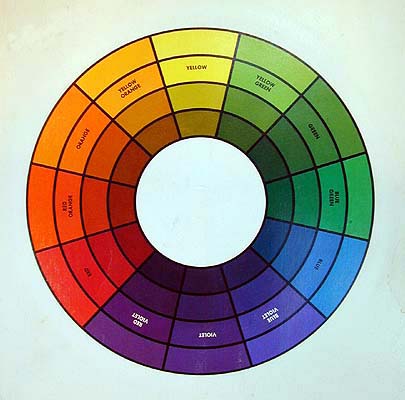How to Use a Color Wheel for Gem Faceting
A color wheel and mixing chart can help novice gem cutters evaluate how well colors will mix in a finished piece. Learn how to utilize these common tools.
2 Minute Read
Artists frequently use color wheels to learn what they'll get when they mix colors together. You've probably used or at least seen a color wheel wherever you've bought plain old paint for your house, too. As a matter of fact, there are quite a few different types of color wheels. Beginning art students usually have to make their own as an exercise.
Although not often applied to colored gemstone faceting, I think a color wheel can aid gem cutters tremendously. In particular, it can help a novice cutter decipher colors and color mixes of pleochroic gems like sapphire and tourmaline. For example, what would a piece of tourmaline rough with a yellow axis and a green axis look like finished? If these colors won't mix well, you'll have to minimize one color and maximize the other when cutting. (In some cases, one color may make the gem easier to sell just because it's more desirable).
A color wheel can give you a good general idea of how the colors will mix. This can help you choose what gem design to cut and what rough to buy in the first place. Of course, faceted gems optically differ considerably from paint on paper. Nevertheless, you might be surprised at how useful a color wheel can be.
Finding Gem Colors on a Color Wheel
Below, you have a standard color wheel. Notice that as the colors get near the center of the wheel, they become darker. Basically, these colors are the same mixes. However, an added black component in the mixes changes the tone. On the other hand, those colors on the outer ring are tints. In other words, white has been added to the mixes.
Treat the black and tint components like the secondary color axis (the one you're not cutting for) on the piece of gem rough you're looking at (like the C axis on a tourmaline that is dark or clear). Then, look at the mixing chart below to see how the colors of your rough will mix.
What are Complementary Colors?
On a standard color wheel, complementary colors go opposite each other, like red and green. You can find different definitions of complementary colors. For gem faceting purposes, however, we're looking for colors that complement each other, but not necessarily "complementary colors." In other words, look for colors that mix well together to create another pleasing color, whether or not they appear as opposites on a color wheel.
However, keep in mind that mixing colors not next to each other will often result in a muddy dull color. For example, if you mix red and green you'll get a brown color. Although that might be useful for painting, it makes a poor gem color, in my opinion.
Do a little research and look for different color wheels and charts. You can find them online as well as at art or paint stores. As you examine them, you'll start gaining a sense of what colors will mix well together. Ultimately, faceting involves color and brilliance, so this can only help you.
Also, don't forget your dichroscope. You can use this tool to visualize how gems with pleochroic colors will appear when cut.
Jeff R. Graham
The late Jeff Graham was a prolific faceter, creator of many original faceting designs, and the author of several highly-regarded instructional faceting books such as Gram Faceting Designs.
Related Articles
Tucson Gem Show 2005
Tucson Gem Show Dates 2006
Labradorite Value and Marketing Issues
Laps Treatment and Care
Latest Articles
800 Years of Mogok: A Celebration in Tenuous Times
What is the Average Gemstone Faceting Yield?
Pyroxmangite Value, Price, and Jewelry Information
How to Identify Emerald Simulants and Synthetics
Never Stop Learning
When you join the IGS community, you get trusted diamond & gemstone information when you need it.
Get Gemology Insights
Get started with the International Gem Society’s free guide to gemstone identification. Join our weekly newsletter & get a free copy of the Gem ID Checklist!
